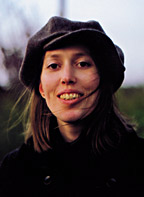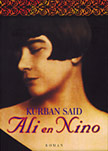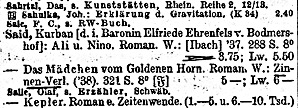|

Winter 2004 (12.4)
Pages10,
12, 14-15
Reader's Forum
"Ali
& Nino" Copyright
by Leela
Ehrenfels
1 "Ali
and Nino" Covers: Novel is Published in 33 Languages
Betty Blair (AI 12.3)
2 Review:
Inside the Soul of a Caucasian Elin Suleymanov (AI
12.2)
3 Editorial:
The World of "Ali and Nino" It's Our World too!
Betty Blair (AI 12.2)
4 Baku
City Tour: "Ali and Nino" Walking Tour - Fuad Akhundov
and Betty Blair (AI 12.2)
5 Photo
Essay: Then & Now: Baku 100 Years Ago at the Peak of Oil
Baron Period (AI 12.2)
6 Article:
How to Collect Kurban Said's Novel "Ali and Nino"
Betty Blair (AI 12.3)
7 Letter:
"Ali & Nino" Rediscovered - Ismail Kafescioglu
(AI 10.3)
  Left: Leela Ehrenfels, who holds the copyright
for "Ali & Nino", Vienna. Left: Leela Ehrenfels, who holds the copyright
for "Ali & Nino", Vienna.
Quite by chance, I discovered the article, "Ali & Nino
Walking Tour" by Betty Blair and Fuad Akhundov published
in your magazine and now available on the Web. [Search AZER.com, AI 12.2, Summer 2004]
To me this was a fortunate situation for more than one reason.
First of all, it introduced me to your truly impressive magazine
- Azerbaijan International. I'm beginning to learn so much about
Baku and Azerbaijan - a place I have never visited but to which
I am connected in various ways. It was fascinating to see the
photos and learn some of the architectural history of the buildings
of the actual places in Baku where much of the novel "Ali
& Nino" takes place.
As you know, I am the holder of the copyright of the two novels,
"Ali & Nino", as well as "The Girl From The
Golden Horn", which first appeared German. "Ali &
Nino" was published in Vienna by E. P. Tal & Co Verlag
in 1937; "The Girl" followed as a Zinnen edition in
1938. Both were published under the pseudonym of "Kurban
Said" and registered in my aunt's name.
  Right: Photo of Baroness Elfriede
Ehrenfels von Bodmershof, who is registered with the pen name
for Kurban Said, author of "Ali and Nino". This photo
was taken in Vienna in 1931. Right: Photo of Baroness Elfriede
Ehrenfels von Bodmershof, who is registered with the pen name
for Kurban Said, author of "Ali and Nino". This photo
was taken in Vienna in 1931.
My aunt's real name was Elfriede von Ehrenfels (1894 -1982).
She was a baronness born into the von Bodmershof family. In the
year she was born, her family was granted the status of nobility
by Kaiser Franz Joseph I (1830 -1916), king of Hungary and emperor
of the Austrian empire. The Bodmershof name had once been Schuster
(a very common name, meaning shoemaker). Her father served as
Finanzprokurator, a top financial advisor for the emperor.
Below: Pseudonym Kurban Said
registered as Elfried Ehrenfels von Bodmershof in 1937 in the
Deuthcher Gesamtkatalog (German Collective Catalog), page 5336.
  In
English: In
English:
"German Collective Catalogue", New Titles, 1935 -1939,
"S", meaning this section refers to the volume listing
names starting with "S", for "Said". Berlin:
Staatsbibliothek, 1940. Page 5336.
In German:
Deutscher Gesamtkatalog, "German Collective Catalogue".
New Titles, 1935 -1939,"S" (for "Said") Berlin:
Staatsbibliothek. p. 5336: "Said, Kurban. 1937 [Pseudonym
for Elfriede Ehrenfels von Bodmershof, Baroness. [38.34682 a]

I became the recipient
of the copyright for "Ali & Nino" through an inheritance
from Elfriede. This is especially meaningful to me since this
little book has such a strong, relevant and timeless message
in its potential to encourage people in finding ways to cooperate
with each other and tolerate differences. The alternative is
for us to pick up our guns and annhilate one another.
Regarding the article, "Kurban Said's novel, Ali & Nino",
AI 12.3 (Autumn 2004, page 61), there are a few things that I
would like to clarify. Elfriede von Ehrenfels was my aunt by
marriage, not my mother, as the article states. This may be confusing
as she also was married to my father Umar Rolf von Ehrenfels
(1901-1980).
In other words, she and her brother Wilhelm (Bodmershof) married
into the Ehrenfels family. She married Umar Rolf, and Wilhelm
married Imma, who was Umar Rolf's sister. Essentially, this resulted
in the two women exchanging their last names. This explains how
Elfriede became my aunt.
My father converted
to Islam in 1926 and was a devout follower until the end of his
life. He was forced to flee Austria in 1938 when the Germans
came looking for him for having written anti-Fascist articles.
This took place just prior to World War II and the Anschluss
(annexation) of Austria to Germany. In the end, Umar Rolf, fled
to India. In the process of all this, the marriage between my
father and Elfriede (who did not follow him there) disintegrated.
Their divorce finally became official in the late 1940s. They
had no children.
  In
English: In
English:
German Index of Books: A Compilation of Books, Magazines and
Maps, published in German Booktrade, with an index and slogan
register, edited by the Bibliographic Department of the Exchange
Association of the German Booktraders in Leipzig.
Volume 21, 1936 till 1940. Title - Index: L-Z, Change of Publishing
Houses, 1937 - 1943. Publishing House of the Exchange Association
of the German Booktraders. 1943.
In German:
Deutsches Buecherverzeichnis: Eine Zusammenstellung der im Deutschen
Buchhandel erschienenen Bücher, Zeitschriften und Landkarten
Mit einem Stich - und Schlagwortregister.
Bearbeitet von der Biblio - graphischen Abteilung des Boersenvereins
der Deutschen Buchhaendler zu Leipzig. 21 Band, 1936 - 1940.
Titelverzeichnis L-Z, Anhang: Verlags - veraenderungen 1937 -
1943.
 Right: Baroness Elfriede von Bodmershof, Right: Baroness Elfriede von Bodmershof, listed for the pseudonym of Kurban
Said as author of "Ali and Nino" (1937) and "Girl
from the Golder Horn" (1938), both in German in Deutsches
Bucherverzeichnis (German Index of Books). listed for the pseudonym of Kurban
Said as author of "Ali and Nino" (1937) and "Girl
from the Golder Horn" (1938), both in German in Deutsches
Bucherverzeichnis (German Index of Books).
Umar
Rolf had been attracted to India from stories his mother told
him during childhood. He subsequently spent 26 years there as
an ethnologist and anthropologist, devoting his life to field
research and to building up the Anthropology Department at the
University of Madras. For his contribution to science and the
Indian society, he was given honorary Indian citizenship. His
main ethnological research related to studies tracing ancestral
descent through matrilineal lineage, and the position of women
in society, worldwide.
In India, my father eventually remarried, this time to a French
woman, Mireille Abeille (born in 1924 in Marseille). She went
on to assist him everywhere in his anthropological research,
including the jungle. This woman is my mother and today lives
in Lichtenau, Austria.
She had gone to India in the late 1950s after studying economics
at Stanford University in California. While there, she was privately
tutored in one of the Southern Indian languages - Malayalam.
She eventually found her way to India to do socio-economic research
related to South Indian Temples. In India, my mother and father
were married in a Hindu ritual.
Another reason you may have thought I was Elfriede's daughter
is that the copyright reads 1937 by Leela Ehrenfels. This is
due to the fact that "Ali & Nino" was first published
in 1937, and I inherited the copyright from its original publication,
despite the fact that I wasn't born until nearly 30 years later.
As a matter of fact, over the years, various people have made
claims to the copyright; for example, Lucy Tal, the widow of
the publisher of the first German edition in Vienna never held
the copyright despite her lawyer's claims in the 1970s.
Even these days, there are people who turn up, from time to time,
claiming to be the "true" writer of the novel or, at
least, to claim that they know who the "true" writer
is.
As Elfriede's heiress, I would like to explain that the documents
that I have in hand clearly show her as the holder of the pseudonym,
"Kurban Said". Deutsches Buecherverzeichnis, the Exchange
Association of the German Booktraders, founded in 1826, had already
been existing for 118 years and continues up to this day.
At that time,
the name of every writer, who published any book in Germany,
and later, also in Austria, was automatically entered in this
registry catalog that, like everything else, was controlled by
the Nazis.
The original contract for publishing "Ali and Nino"
was signed in 1937 between Elfriede Ehrenfels and E.P. Tal, the
publisher. We have documents to show this as well.
I am aware of the many discussions and claims being made about
the identity or person behind the fictictious name, "Kurban
Said", and I feel that more must be said about Elfriede.
I'm convinced it is essential to examine her role and analyze
her work in the context of what was going on in Europe at the
time. This has been part of the journey that I have undertaken
since inheriting the copyright. It seems that it is now my responsibility
to share more of what I have learned about this truly impressive
woman.
Thank you for the inspiring work that you are doing with Azerbaijan
International. This magazine has been a delightful revelation
to me. It is thrilling for me that "Ali & Nino"
has now been published in 24 languages, and has more than 100
editions and reprints, making it the most widely published book
in Azerbaijan's history!
Editor's note: As of January 2008 the novel "Ali and Nino"
has been published in 30 languages.
The love story
of an Azerbaijani son of an Oil Baron (Muslim) and a Georgian
princess (Christian), which is set in Baku on the turbulent eve
of the Bolshevik Revolution in 1918, serves today as a beacon
of hope that people do have the capacity to bridge the gap between
what really are outer or superficial differences in social, traditional
and religious practices. The story of "Ali & Nino"
is a message of love and tolerance. I'm convinced that the more
people know this novel, the more they are likely to realize that
the only solution to our present-day world problems lies in peace.
Leela Ehrenfels
Vienna, Austria
______
Editor: Plans
are being made to publish a major article with Leela in Azerbaijan
International about the role of Elfriede Ehrenfels in the creation
of "Ali & Nino". To view more than 90 covers of
the "Ali & Nino" editions in 30 languages, or to
take the "Ali &
Nino Walking Tour", search "Kurban Said" at AZER.com.
Back to Index AI 12.4 (Winter
2004)
AI Home
| Search | Magazine
Choice
| Topics
| AI Store | Contact us
Other Web sites
created by Azerbaijan International
AZgallery.org | AZERI.org | HAJIBEYOV.com
|






 Right: Baroness Elfriede von Bodmershof,
Right: Baroness Elfriede von Bodmershof,